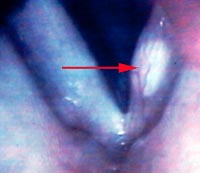Consider the anatomy and physiology of the voice by following the voice from the lungs to the lips. The breath stream, referred to as the “generator” of the voice, originates in the lungs. This generator provides a controlled flow of air which powers the vocal folds by setting them into motion. Patients with inadequate pulmonary volume (breath support) will have sub-optimal vocal production. Vocal pedagogues realize the importance of the generator (lungs) and often begin coaching their students with techniques to improve and optimize breath support.
The human larynx has three vital functions. In order of phylogenetic importance they are…
- Airway protection (prevention of aspiration)
- Respiration (breathing)
- Phonation (talking)
When we speak, the vocal folds approximate and vibrate to produce voice (see image of anatomically normal closed or adducted true vocal folds above). When we breathe the vocal folds open or abduct and allow air to flow from the lungs through the mouth and nose and vice versa. When we eat, we reflexively stop breathing and the vocal folds approximate to protect the airway and keep food and drink out of the lungs.
The vocal folds do not operate like strings on a violin but actually are more comparable to a vibrating woodwind or reed instrument (clarinet) or like vibrating lips “buzzing”. When we slow down the buzzing motion of the vocal folds as with videostroboscopy, we can appreciate that they have a unique and wave-like motion. Click here for a slow motion video clip of normal vocal fold vibration.
Specifically, as the vocal folds come together, they meet at the bottom edge first, then come together along their medial edge. Then, as the top edges approximate, the inferior edge releases separating from bottom to top with the air stream blowing them apart and the cycle begins again. The vocal folds are referred to as the “vibrator or oscillator“. Small lesions of the vocal folds, such as vocal cysts or nodules (images below) can have drastic effects on voice production. Any lesion that affects vocal fold vibration can cause dysphonia or “hoarseness”.
Vocal fold cyst (arrow) of left vocal fold.
Bilateral vocal fold nodules (arrows)
It is the alteration of this vocal fold vibration as it moves up the vocal tract that gives the voice its individual and unique resonance. The three-dimentional cavity, or “resonator“, that provides this intonation includes an individual’s oral cavity, nasopharynx, sinuses, and nasal cavity. This can become altered by changes in physiology or structure itself. For example, if someone has a stuffy nose, his/her resonance becomes altered (hyponasal). If someone has a short palate from a surgical procedure or a congenital cleft palate from birth, they may have excessive nasal resonance (hypernasal).
Once the sound is modified by the resonator, it becomes shaped by the lips and tongue, or “articulators“, into spoken language. This is a more finite, complex and extensively coordinated activity involving structures of the tongue, cheeks, teeth and lips. Problems with the articulators can be due to neurological problems, developmental problems, neoplastic or sensory problems.
It is the intricate association between an individuals generator, vibrator, resonator, and articulators that produces the sound that emanates from the human mouth.



